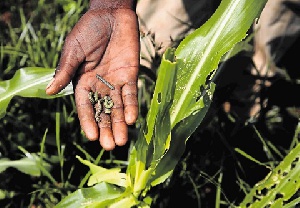General News of Tuesday, 10 April 2018
Source: gbcghana.com
Army worms resurface in Ashanti region
Radio Ghana can authoritatively report of a re-emergence of the Fall Army Worms on maize farms in the Ashanti region.
This follows a visit to some affected farms in the region to ascertain the level of infestation and havoc being wreaked by the pests.
It emerged however, that an early application of the recommended agro chemicals on the maize farms can substantially subdue the destructive worms.
Radio Ghana's Correspondent, Nicholas Osei-Wusu, who has been closely monitoring the development following the start of this year’s major cropping season reports that, the Ashanti Regional directorate of Agriculture has confirmed that traces of the worms invasion have been found throughout the region, even though not at an alarming rate.
The Fall Army Worms, identified to be migratory with the Americas as the origin, were first detected on farms in the Ashanti region during the minor maize growing season of 2016.
Their infestation however became pronounced throughout the farming seasons of last year leaving in their trail severe damage to maize production.
Against any hope that the worms’ invasion had been arrested for good, they have re-emerged. A visit to Sokwai, a farming community in the Atwima Nwabiagya district revealed a mixture of situations regarding the fall army worms’ infestation.
On one hand, a farmer, David Yaw Sanaki, is battling the worms on his four-acre maize farm.
According to him, upon detection of the invasion three weeks after planting, he has applied a certain agro chemical about three times at the recommended time period of between five and six AM on all three occasions. However, the impact has been minimal.
Another backyard maize farm less than three weeks old is also being invaded by the destructive pests.
On the other hand, a nearby maize farm which is at the tassling stage, is doing very well.
The farmer, James Kofi, who is practicing mixed cropping, told Radio Ghana that he applied the same chemical used for the rice farm on his maize farm days after germination during which period the worms find the stock suitable for feeding and that this has produced the desired result.
During Radio Ghana’s visit to the Ashanti Regional directorate of Agric to seek official’s response to the situation, the Regional Management was locked up in a strategic meeting reviewing the fall army worms re-emergence in the region and to plan effective strategies to manage it.
In an interview, the Regional Director of Agric, Reverend John Manu, confirmed that after a field tour in the region during the week-end, it was observed that about 17 of the existing 30 administrative districts have traces of the pests’ invasion.
According to the Regional Agric Director, everything possible is being done to reduce the level of potential damage the fall army worms could cause to production adding that already, the Food and Agriculture Organization, FAO, is supporting a communal voluntary or ‘Nnoboa’ spraying gangs system to engender the most effective chemicals application.
Reverend Manu described the Agric Extension Officer-Farmer ratio as unacceptable.
It currently stands at One Agric Extension Officer to one thousand 500 farmers, a situation that is also compromising on the efficiency of the Officers.
The recommended ratio is One to 500. He and therefore appealed for a strategy to close the gap.
The Regional Officer for the Plants Protection and Regulatory Services Unit of MOFA, Godson Tetteh, disclosed that the worms’ infestation during the 2017 season led to a 15 per cent shortage in maize yield.
Mr. Tetteh said this year, some chemicals have been approved and made available for farmers to apply.











